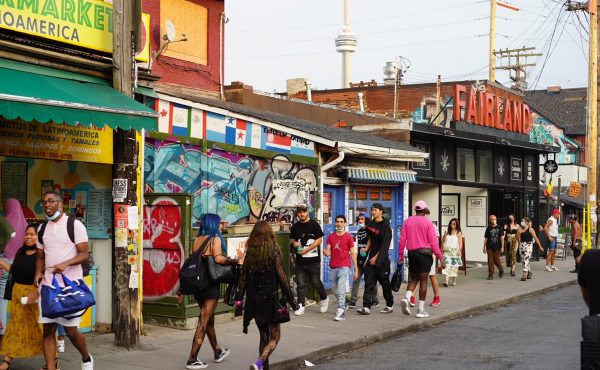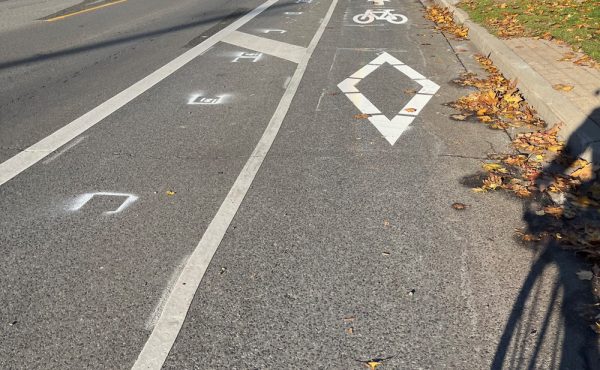
The City of Toronto is announcing today that the project for revitalizing the high-end shopping strip along Bloor West from Church Street to Avenue Road is finally going ahead (it was originally proposed three years ago). The project includes widened sidewalks with a special new design, and new street trees with a special irrigation system. Some public art will probably be included too. A lane of parking will be removed to accomodate the new sidewalks.
The original plan was for the city to contribute $10 million dollars to the project, which would be matched by the Bloor-Yorkville BIA (Business Improvement Area) and possibly by other funding sources (originally it was hoped that upper levels of government would contribute, but their reluctance is what delayed the project).
In Spacing‘s pedestrian issue, we published an analysis of the original project, although details may have since changed.
So the city is spending a major chunk of money on making a swanky shopping district for Toronto’s wealthy even swankier. Here is the question. Is this:
a) a good thing, because the city is putting a real investment into expanding and improving the pedestrian realm in one of the most heavily travelled pedestrian areas of the city, or
b) a bad thing, because the city is devoting a significant amount of its scarce cash to pandering to the wealthy while it neglects many more pedestrian areas used by average-income people where this cash could make a bigger difference.
(For perpective — the city’s yearly sidewalk improvement budget is less than half the $10 million first proposed for this project: $2 million a year for adding missing sidewalks, and $1.6 million to the Urban Design Section of City Planning to make a small number of sidewalks a bit nicer than standard every year).
I, personally, don’t know what to think. I kind of think both sides at the same time. I’d like to hear other people’s opinions.




15 comments
wider sidewalks anywhere in the city = good thing
Neat! 🙂 It’s a shame it didn’t extend just a little more westward to re-connect Yorkville and the University like back in the Rochdale days!
I also share people’s concerns over the apparent lack of bike lanes, but the project looks beautiful, and I am glad they went ahead with removing some parking.
Yo, where’s my bike lane?
So in other words, the city could triple the budget for sidewalk improvements and bring a better urban environment to a lot of people, or it could spend that money on making streets look nicer for people who shop at Swarovski and Williams-Sonoma?
That’s a no-brainer to me.
I’d say that wider sidewalks are always a good thing, and that a shiny rich-white-folk neighbourhood is always good for things like tourism and intensification (read: economy). And why no bike lanes? ‘Cause rich people don’t like bikes, as they interfere with their driving.
If the less than 80k/year, non-white, bike-riding community wants things like wider sidewalks on Queen and bike lanes on Bloor, it has two choices:
1. Push politically for these things by electing people who think like they do (election is coming up eh?)
Make riding a bike sexy and cool so rich people will want to do it.
This is why politics tends to be the common battleground.
Whoa class war! Winners, H&M, The Bay, some of the low endish stores in Yorkville, Jacob, Tim Hortons, — student housing (the tower at Bay and Charles is largely U of T students), those rundown-looking apartment towers a block south of Bloor, the Toronto Reference Library….this area isn’t the domain of “just the wealthy.” It’s fairly mixed. And it’s one of our most pedestrian-used areas (walk there during the day — it’s like one of those shots of NYC, with people-gridlock), so this is mostly good news.
It’s fine to debate the details (bike lanes, etc.) but the “rich white people” talk is sloppy ideological thinking (which should be an oxymoron, but isn’t) and says to me people aren’t actually paying attention to what is there.
Jane Jacobs famously called for sidewalks of 35 feet in width in cities. Are we getting there on Bloor with the Brown and Storey proposal?
Jacobs was no bike rider though, and it’s to someone like Enrique Penalosa of Bogota whom we must turn to get a perspective on a major project like this that simply ignores the needs of cyclists.
Penalosa’s institution of cycle-ways and monthly Car-free days during his time as Mayor was specifically aimed at the idea that folks on foot or on bikes are equal to each other, and this was a worthy aim of civic culture: the removal of class distinction.
It’s sad there’s no one of Penalosa’s stature in our own city hall, but interestingly, his brother Gil is “planning adviser for Mississauga’s community services,” just across the town line.
Who’s Gil? Why he was the head of Transportation Planning in Bogota during his famous brother’s tenure as mayor. He’s the one who painted the lines on the bikelanes.
Anyone know how to get him to pay our city a visit?
“Nobody goes there anymore. It’s too crowded.”
It’s true this is a very mixed area – I shop there quite often because it’s near where I work.
However, an important difference between this area and many other heavily-used pedestrian shopping areas is that the rents along this strip are significantly higher than elsewhere in the city, and thus it includes shops that cater to a high-end crowd in a way that other areas do not do to the same extent.
Also relevant is that the city in general has a policy of sharing costs 50/50 with BIAs for streetscape improvement projects. So it does fit with city policy – what stands out about this one is that the BIA can afford such an unusually large investment.
The question is, is this wealth difference a factor in the city giving such a large chunk of money to the project? And could the money be better spent elsewhere? Quite possibly the answer is it’s a good place to focus money – as Shawn says, it’s a destination for many different kinds of people. I think it’s a question that is relevant and worth discussing, though.
As someone else pointed out to me, it is also good to see a BIA recognize that pedestrians are more valuable than parking.
Good? Bad?
It’s a start.
Take all the parking off major arterials, widen sidewalks, and put in a bike lane (separated by a curb as in Montreal). In the short term it should cost very little: a line of curb along the old white line.
After all, what portion of people get a spot on the arterials vs having to park on side-streets? Car drivers had better get over it: there’s going to be precious little oil within ten years. Start fixing the damage now!
re: reaching Penalosa’s brother… um, well, if that was a serious request to get him to T.O. as a speaker I may potentially have a contact. Perhaps get a hold of Spacing staff and have them send me your email address and we can discuss further. As for the sidewalk, well, widening sidwalks and including mature trees is always a good thing, and the wealthy mix with us regular folk all the time especially in the summer on hot nights, especially along Yorkville & Cumberland, to people-watch, eat ice cream, and watch the luxury cars motor by. Perhaps this will extend the promenade out to Bloor and make it more friendly and human.
There is no more sensible place to restrict cars a little bit than beside the subway, and people do need wider sidewalks – sometimes. But the peds already have a sidewalk, a good eleven feet with fancy granite pavers and some trees actually survive the smog for a year or two. This B&S plan is an outrageous sell-out of cyclists, who desperately need safer east-west travel for their trips. Why can’t we take out a lane of parking for bike lanes here? Will we ever try to curb smog and greenhouse gas emissions by promoting bike travel in a meaningful way? The cost of doing 8kms of bike lane along Bloor as the first stage of TaketheTooker, from Sherbourne to High Park, is only $200,000 but our politicians tend to be too “carrupt” to even begin on a facility that could bring safety to cyclists. Notify the City Legal Dept. that you’ll sue for failure to provide safe passage: there’s to be a study of the TaketheTooker given to Works Cttee in July; meanwhile start counting the smog days and ask Miller what’s he going to do for fresher air?
Why do we always have to sneer at efforts to beautify public spaces? I say kudos to the Bloor/Yorkville B.I.A. for going to the effort to undertake this project. Bloor Street belongs to everyone and with the new cultural institutions being built, could become a joy to walk on. I think that we should applaud this project and hope that it will spur the city and its citizens on to invest in the public realm downtown. Our downtown streets are shabby and present a poor image to visitors from elsewhere. We all benefit when we take pride in where we live. Even residents of left-wing Montreal know that. You can support social justice and love beauty. They aren’t mutually exclusive.
The author of the article refers to this section of Bloor as swanky. Unfortunately the street itself has been far from swanky for a long, long time. It’s pretty shabby looking actually.
This city needs desperately to have an area that can compete with the Madison Avenues and Rodeo Drives. It’s only a few blocks but it will make a huge difference to the international perception of Toronto. If you look as shabby as we do everywhere, then that’s how we’re going to be viewed around the world. At least let’s have this part of the city look beautiful. The rest just looks like crap.